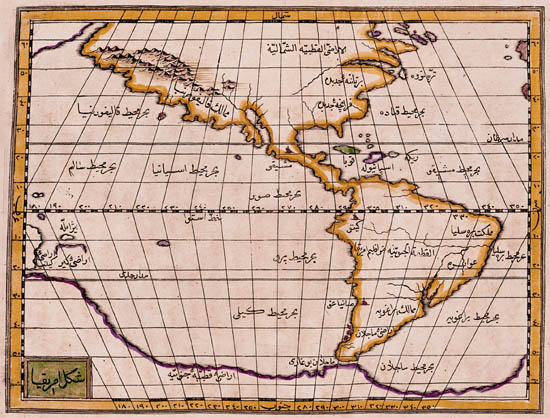
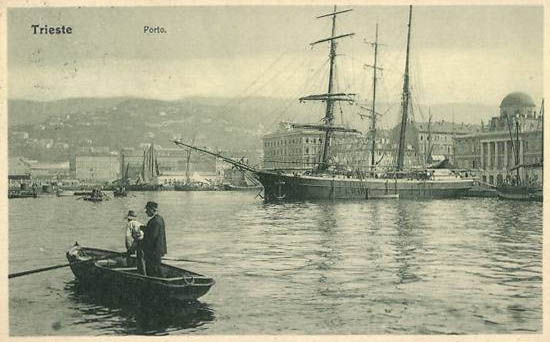
The story of Trieste, founded by Illyrians, ruled by Rome, then Byzantium, then enduring conflict with the Most Serene Venetian Republic and then, unsteadily, coming under the Hapsburgs, Napoleon, or intermittently finding purchase as a free city state, finally gives us today an Italian city braided also with thick Slavic and Germanic strands. James Joyce made it his home for many years, and his friendship with Italo Svevo helped make the latter a treasured voice in Italian literature. Each is memorialized in his own city landmark.
But our subject here is another Triestine landmark, an understated one of almost vanishing subtlety. It is no higher than the pavement on which it rests, and few that pass pay it any heed. Most people that I observed, Triestines and travellers alike, tread callously upon it as they go about their activities. I came across it simply as an accident of my haphazard wanderings and, as such things often do, it struck a resonant chord. I am speaking of the Trieste Meridian.
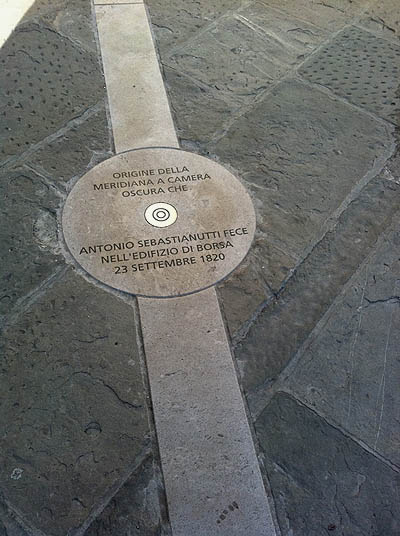
The word “meridian” is from the Latin words “meridianum” and, as such, it marks the line over which the sun is always at its daily zenith the year round for a given location. This is the noon or “midday” alluded to in the Latin above; that is, the middle of the day.
If I define a meridian in geodetic terms, saying that it is any section of a great circle on the terrestrial sphere that has both planetary poles as endpoints, we can understand, with perhaps a bit of effort, what is meant. But there is the lingering feeling that language this precise, ironically, starts to sound meaningless. In simpler terms, we may say that any straight north-south line on the earth’s surface is a meridian. And that there are infinitely many of them. In choosing this meridian, and making it manifest on the pavement, the Triestines are saying that it is somehow special.
London and Paris
It is special, but not unique. There is, for example, the consensus Prime Meridian that passes through the Royal Observatory in Greenwich, a London borough, and, at 0°, is the meridian from which all other conventionally understood longitudes are measured. Before this was accepted, however, the meridian at Paris was considered by many a competitor for the honor. On many maps of French origin, in fact, you can still see both meridians are referenced in the margins.
During the International Meridian Conference in 1884, held in Washington, U.S.A., a good many alternative meridians were discussed, some on the basis of political neutrality and others for reasons of tradition. One proposal supported placing the Prime Meridian at El Hierro (Ferro), in the Canary Islands, a practice established in 1634 by the French, but based on a tradition dating from Ptolemy, who considered the “zero point” to be the westernmost point in the known world (or, in 1634, the “old world”). But as Greenwich had become the de facto standard gradually over time, it was generally felt, I suspect, that it would be best to leave it be. The French had to leave the conference dissatisfied.

But there is (was!) also a system of local prime meridians, intended to serve the limited chonometric needs of the people in their surroundings. Their august presences have dissipated over time from having been essential local features and exemplars of the timekeepers’ art, until now they are little more than atrophied historical appendages, modest curiosities at best. My favorite kind, as a matter of fact: the withering obscurity. For the curious, Wikipedia tells more about the Prime Meridian, and even offers a list of other prime meridians that are of merely local importance.
Here I will share what I've managed to find, in summary form, about the two prime meridians I've happened to trip over and, at the end, I wonder aloud how many more exist.
Trieste
The Trieste Meridian (13°46´11˝ E) is marked by three inscriptions on a narrow strip of pale stone cutting a swathe through the cement paving slabs of the Piazza della Borsa. The first simply identifies it as “Meridiano di Trieste” and the next gives instructions for how to make oneself the gnomon of a sundial, and read the time of day with your own shadow. The final inscription memorializes the efforts of its designer, the Friulian scientist Antonio Sebastianutti, who accomplished the work in 1820. The meridian strip’s northern end terminates at the base of the outer wall of the Camera di Commercio (Chamber of Commerce).
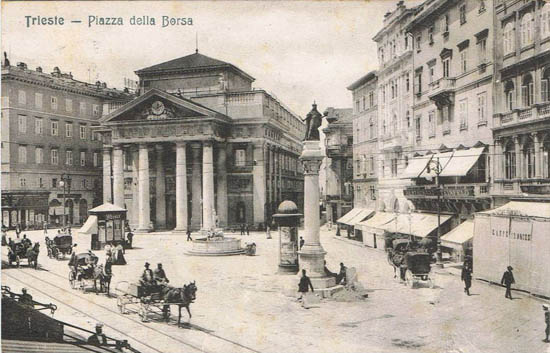
The inscription also alludes to a “camera obscura” as part of the ensemble, but for that, you must enter the abutting building. The meridian as demarcated outside continues into the interior of the building, where an indiscernible opening high in the wall allows a shaft of sunlight to penetrate and project the solar disc onto a series of markings on the floor of the entry hall, which discloses the precise time of day. When it was devised, the purpose of this elaborate, and strikingly elegant, system was to provide a precise method for ships long out at sea, upon returning to port, to calibrate their chronometers, which in those days were vital to navigation.
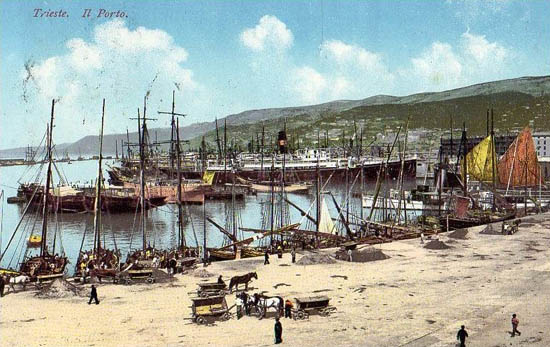

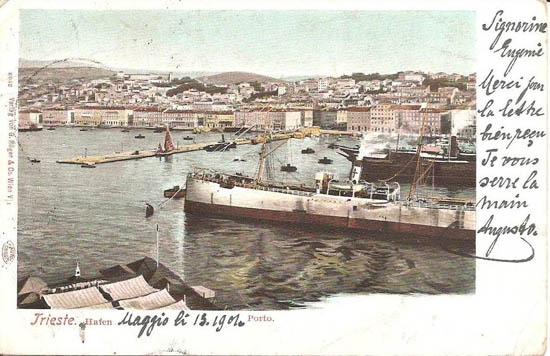
Prague
The start of my journey to Trieste began in Prague, a city that, interestingly, also boasts its own prime meridian. The Prague Meridian (14°25´17˝ E) passes through Staroměstské náměstí (Old Town Square), and, if you can manage to elbow your way through the crowds of tourists, you will see that it is marked by a brass rule and plaque embedded among the cobbles, pointing obliquely in the general direction of the memorial to Jan Hus. But this ensconcement is merely a historical ghost, marking a trace of a shadow of a hint of something that no longer exists.

Until the spread of railroads and the subsequent introduction of Standard Time, the city of Prague, like probably every other city and town in the industrialized world, had its own local time. The local time for each place varied, for the simple and logical fact that the sun was at zenith at a different time in each location, depending on its longitude. Prague by tradition and convention established that midday was the precise time that the
 Mariánský sloup (Marian Column), a 16-meter-high devotional column topped with a shining effigy of the Virgin, cast its shadow along a true north-south line onto the pavement. The line of that fleeting shadow is the Prague Meridian.
Mariánský sloup (Marian Column), a 16-meter-high devotional column topped with a shining effigy of the Virgin, cast its shadow along a true north-south line onto the pavement. The line of that fleeting shadow is the Prague Meridian.A separate, but connected, inscription among the paving stones of Old Town Square marks the former site of the Marian Column. The column was pulled down shortly after Czechoslovak independence in 1918 by a certain group of scoundrels, still smarting from the Bohemian defeat at the Battle of White Mountain 300 years before, claiming that the column still represented Hapsburg repression.
The column, although erected in the period of the many so-called “plague columns” that appeared throughout central Europe during the era, does not strictly fit that archetype. It was begun in 1650 “…in thanksgiving to the Virgin Mary Immaculate for helping in the fight with the Swedes,” according to Wikipedia. Its aim seems at least partly political: Golo Mann, writing in “Das Zeitalter des Dreißigjährigen Krieges,” from the Propyläen-Weltgeschichte, reports the curious fact that, officially, the Virgin Mary had been appointed the commander-in-chief of the Austrian army during their wars with the Protestants. The Battle of White Mountain against the Hussites was their first victory after having done so.
To this day there are unfulfilled initiatives to re-erect the structure, and the City of Prague has taken it under advisement. But still no decision on the matter has been handed down. It remains controversial. At issue are, not only the cost of the reconstruction, but also concerns by architectural experts that the existing documentation of the original column is insufficient to create a historically correct structure. The inscription marking the site of Marian Column reads “Here stood and will stand again the Marian Column,” but the words “and will stand again” have apparently been intentionally chipped away by person or persons unknown.




And now, You
After stumbling upon these two lesser meridians, that their local communities evidently find of enough significance to devote treasure and effort to their commemoration, I am left to wonder, what other minor prime meridians are out there that few but local citizens know about? We have Wikipedia’s list (linked above) to tell us of some, but, for the sake of the game, I am going to presume that there are many more.
So, please, dear reader, I ask you, if you should know of one, maybe in your home city, or that you’ve come across in your own travels, will you please leave a comment to this post with some small bit of information about it? And if you should have a picture of it, could you a share a copy with us? I believe it could form a very interesting collection of crowd-sourced knowledge that anyone interested in such things might benefit from.
In Closing
We all know that the features that appear on a good map correspond to features that appear somewhere on the Earth. The model for understanding mapped space is abstracted and distorted, projected onto a two-dimensional space so that it can be printed on flat paper. The map is peppered with dots representing population centers, squiggled with borders, and ruled with lines allowing coordinates to be plotted for quick reference. But what happens when we turn the idea around and begin to place markers on the earth that correspond to the way space is organized on maps? Our geodetic techniques give us crystalline constructs of pure imagination, an idealized conception that helps clarify relationships, sometimes at the expense of precise detail. In marking these imaginary lines upon the face of the earth, the brain’s inner theatre exercises its will in form and matter. The pure constructs of mental effort protrude into the very space they are attempting to describe, and therefore change it. So now there is something new on the earth, a monument to a meridian line. In turn, it now it must appear on some map, lest the map become outdated and false.
But this is a tangled hierarchy that I will leave to Borges and the philosophers.
Let me immediately tell you about a similarly famous local meridian, the Nagyvárad Meridian (today Oradea in Romania). The Bishop of Nagyvárad and later Archbishop of Hungary János Vitéz asked the Viennese astronomer Georg Peuerbach and his student, the famous Regiomontanus to compile a handbook of the eclipses of the sun and the moon. The Tabula Varadiensis (1464) considered the meridian of Europe’s first astronomical observatory, established in the fortress of Nagyvárad, as the Prime Meridian. The Tabula Varadiensis was also used by Columbus and Vespucci. The Astronomy Club of Oradea is still called “Meridian Zero” :)
ResponderEliminarThis is exactly the kind of example I was hoping for! It also seems like the Nagyvárad Meridian a pretty important historical prime meridian, as it has a some meaningful claim to being the first, and was very important to the early trans-Atlantic navigators.
ResponderEliminarThe wikipedia article has a nice old map of Oradea/Nagyvárad that shows clearly the fortress you mention, I believe.
Unfortunately there is no such "prime meridian" near my place of abode, but I would like nonetheless to say something about a word related to the word meridian, i.e. the adjective meridional.
ResponderEliminarWhat you said above makes perfect sense to me: "The word “meridian” is from the Latin words “meridianum” and, as such, it marks the line over which the sun is always at its daily zenith the year round for a given location. This is the noon or “midday” alluded to in the Latin above; that is, the middle of the day."
About the word meridional, the American Heritage Dictionary has this to say:
1. Of or relating to meridians or a meridian.
2. Located in the south; southern.
3. Of or characteristic of southern areas or people.
Definition N° 1 should be fine for everyone, but definitions N° 2 and 3 might not be universal. It has been discussed several times (here and there for instance, but also over there at a Norwegian blog), but I cannot resist bringing the subject back here, where things meridional (acceptation N° 1) are being put on the table. As some might see it, definitions N° 2 and 3 are good enough for people living north of the tropic of Cancer, i.e. those for whom the sun is always in a southerly direction at midday. But for those living south of the tropic of Capricorn, at true midday, i.e when the sun is right above your local meridian, it is to be seen in a northerly direction. Surely in such countries (Australia, Argentina, etc.), meridional should refer to the north, no?
Siganus Sutor, living 55½ degrees east of the Paris meridian
Gábor commented to the Hungarian version of this post:
ResponderEliminarThis year, I have visited the Basilica di San Petronio in Bologna, and there in the interior of the church passes a similar meridian line, which ends in a marble plaquet on the wall, with the inscription: MERIDIANAE HVIVS LINEAE TOTA LONGITVDO INTRA VERTICALEM ET CENTRALEM SOLIS RADIVM IN HYBERNO SOLSTITIO EST SEXCENTIMILLESIMA PARS CIRCVITVS VNIVERSAE TERRAE
My addition:
that is, “the full length of this meridian line at the vertical and central beam of the sun [that is, on the zenith?] at the winter solstice is a six hundred thousandth of the whole circumference of the earth”
that is, it must be a 66,7 meter long line
If such winter solstice – that is, Christmas – meridians are also taken into account, then there will be even more “special meridians”. It seems that such ones were observed and marked in a number of medieval churches. Now I only recall the medieval village church of Velemér in Western Hungary, where in the morning (that is, not noon) of Christmas day, the first beam of the rising sun penetrating through the small window of the apsis, falls on a certain mark. But there are surely more examples of this (perhaps I have read something similar on a Danish village church, too).
Gábor's point on the meridian line in San Petronio is very well taken.
ResponderEliminarI am not from Trieste and I could be mistaken, but I doubt that the meridian line in Piazza della Borsa was ever meant to mark a prime meridian.
In Italian the word meridiana commonly means sundial, and more technically denotes a meridian line marking exactly noon, which Wikipedia suggests can be translated as noon mark in English. The best Wikipedia article seems to be the German one for Mittagsweiser.
A precisely built indoors meridian line, or meridiana a camera oscura, used to be an accurate scientific instrument with an important role in the development of astronomy.
The one in Trieste, as you report, was built in 1820 to help ships set their chronometers. The continuation outdoors in the square is very recent (from July 2010) and essentially decorative. A brief description by the engineer and sundial enthusiast who designed it is here.
The older and more scientifically and historically important ones were typically in great churches. The reference is surely Heilbron, John L. 1999. The sun in the church. Cathedrals as solar observatories. Cambridge, MA: Harvard University Press (which I have not read). A related webpage may be of interest.
San Petronio has possibly the most famous meridiana a camera oscura, designed and built by the same Gian Domenico Cassini who went on to direct the Paris Observatory, building a meridian line there as well and measuring the Paris prime meridian. Also famous are the ones in the cathedrals in Florence and Milan, in S. Maria degli Angeli in Rome, and in S. Sulpice in Paris. There were and still are many more: here's an article (in PDF and in Italian) listing 74 extant ones in Italy.
Thank you very much for all the information!
ResponderEliminarIn the meantime, while looking for a photo of the meridian of San Petronio to be included, I have also found exhaustive information on it, plus a good overview of Heilbron’s book. I think it will be worth to make a summary for Río Wang.
There are dozens of prime meridians in my part of the globe, for the reasons which have nothing to do with vanity of nations or chronometers of skippers. It has everything to do with private land ownership, and with a need to keep thorough records of boundaries land parcels.
ResponderEliminarThe traditional US system of dividing the land into Townships, Ranges, and Sections, and the subdividing further, is quite complicated, and I'll refer to Wikipedia for details (I'm sort of afficionado, having spent a lot of time looking for XIX c. geodetic and survey markers in the wilderness of the American West, some as unconspicuous as a small copper nail with crosshairs)
What's important though is that the cadastral divisions were all relative to a regional Principal Meridian and Base Line. They had to be regional because the nation-wide surveys have not been been completed yet by the time the land-ownership records were compiled.
Mountain ranges in particular stood in the way of land surveys, and in the Rocky Mountains, there are numerous isolated local baselines and meridians. High in the mountains, even local lines were hard to refer to, so old mining claims there traditionally refer to very locally designated US Mining Monuments instead of Township / Range / Section. Native American Nations often have their own meridians and baselines, too.
Here's a snapshot of the variety of Principal Meridians in my area, and the 1847 Survey and 1855 Meridian Monument here in town.
I came across mention of the solar clock in the Basilica di San Petronio in Bologna when I was doing my research for this post, but I set the information aside for future study. I would say I would very much like to visit it some time in the future, as well as other sites that have similar contrivances connected with geodesy and timekeeping.
ResponderEliminarI also noticed the similarity between Cassini’s solar clock at San Petronio and Sebastianutti’s in Trieste, and I wondered to myself whether this was something prevalent in Italy; or if it is more general. St. Sulpice in Paris is mentioned, so I guess perhaps it’s the latter. It has the feel of something descending from a Renaissance or Enlightenment way of thinking about the world. But as I am not a trained historian, I leave it up to those more knowledgeable than I in this matter.
In light of this information, I tend to agree with Giacomo Ponzetto’s comment that the “Meridiano di Trieste” is more of a solar clock than a Prime Meridian, and I am quite happy to have more insight and better information on this matter. Nonetheless, it does seem to mark a north-south line, which would (if true) at least make it a meridian. (And thanks for all the great reading all of you have given me to do!)
MOCKBA points out the rather different motivations for creating meridians in North America. I am somewhat familiar with these, being a native Iowan and interested in geodesy. The counties in Iowa (and many states) tend to be rectilinear, rather than following natural boundaries. As the land between longitudes becomes narrower as you go north certain "corrections" have to be made to accommodate the square sections. In Iowa, there is a town called Correctionville for precisely this reason; there are other towns across the country with names such as this. (And again, thanks for the links!)
These papers by Prof. Costantino Sigismondi available on the arXiv may be of interest:
ResponderEliminar"Astronomy in the Church: The Clementine Sundial in Santa Maria degli Angeli, Rome",
and
"Measuring the position of the center of the Sun at the Clementine Gnomon of Santa Maria degli Angeli in Rome"
arxiv.org/pdf/1106.2976
arxiv.org/pdf/1201.0510
Thanks Studiolum for the Heilbron link.
Este comentario ha sido eliminado por el autor.
ResponderEliminarOf course in Old Europe, where land ownership and land tax records existed long before geodesy, the cadastral maps were tied to local landmarks rather than to meridians (as is the case with the imperial Austro-Hungarian Kataster, with its compendium of beautifully colored local map sheets). The imperial military cartopgraphy, on the other hand, relied at lat/lon, and used ab Ferro notation (counting from the Hierro Island already mentioned in this blog entry).
ResponderEliminarA few more American meridian tidbits. A very long street in Los Angeles is named Base Line Boulevard because, yes, it goes West to East on the base line of San Bernardino Meridian. Another name which pays homage to the surveyors :)
And locally in Utah, where of course the Cartesian always starts from the Temple, there was (in addition to the Meridian Monument on the Temple wall which I already mentioned), also a Meridian Monument Company. Only it didn't have any connection with geodesy. Instead, it provided stones for graveyard monuments, and its owner, a Russian immigrant, conveniently changed his name to Mr. Meridian. As he grew old and the business folded, he continued to live as a recluse in a former quarry in a house built of unfinished gravestones, now a landmark called Meridian Monument Ruins.
@ Lloyd Dunn: My astronomical knowledge is very limited, but as I understand it a meridiana in the narrow sense of a noon mark has to be exactly aligned with a meridiano or meridian, or else the sun would not shine upon it at noon every day of the year.
ResponderEliminarSo I think you're right that the one in Trieste is indeed a meridian, and after all it is marked as meridiano di Trieste, which seems to confirm it.
It turns out that Il Meridiano di Trieste was a local newspaper, which seems to have merged with Trieste Oggi. Maybe it was named after a prime meridian after all?
I could find on Google Books an 1824 description of the city that mentions that the solar clock is aligned to the Trieste Meridian:
"la bella meridiana solare eseguita dal bravo meccanico Antonio Sebastianutti, formata da una fascia rettangolare scolpita in pietra viva e collocata nella direzione del Meridiano di Trieste, e da un foro circolare aperto nel muro della loggia all'estremità meridionale della fascia, alto piedi 18 per dare ingresso al raggio solare."
There's also a nautical almanac from 1842 which references the Trieste Meridian as the one used to compute the timing of the tide in the port. That wouldn't be a prime meridian, but surely something that would have mattered to the merchants who commissioned the meridiana.
We can hope that someone from Trieste can enlighten us further. In any case, thanks for an interesting and stimulating post!
Similar to what MOCKBA said about Los Angeles, here in San Jose, California, we have a street named Meridian Avenue which runs north-south on the Mount Diablo median.
ResponderEliminarThe original surveying job was not very accurate, and later it became necessary to correct it, with consequent adjustments to the property lines along the street.
The street was extended south into new suburbs in which the street grid was not north-south, keeping its name while veering decidedly to the east. Further south yet it slews back and forth several times as much as 45 degrees to the east and west before thankfully changing its name.
To me it tells a story of idealistic beginnings followed by deteriorating engagement.
Someone in Poland, in Krakov city, want to make a Honorus Cracov Meridian. On Facebook there is a page of his project with houndreds photos of meridian's markers and monuments from all over the world. It's amazing!
ResponderEliminarhttps://www.facebook.com/pages/Honorowy-Po%C5%82udnik-Krakowski/498347483509122